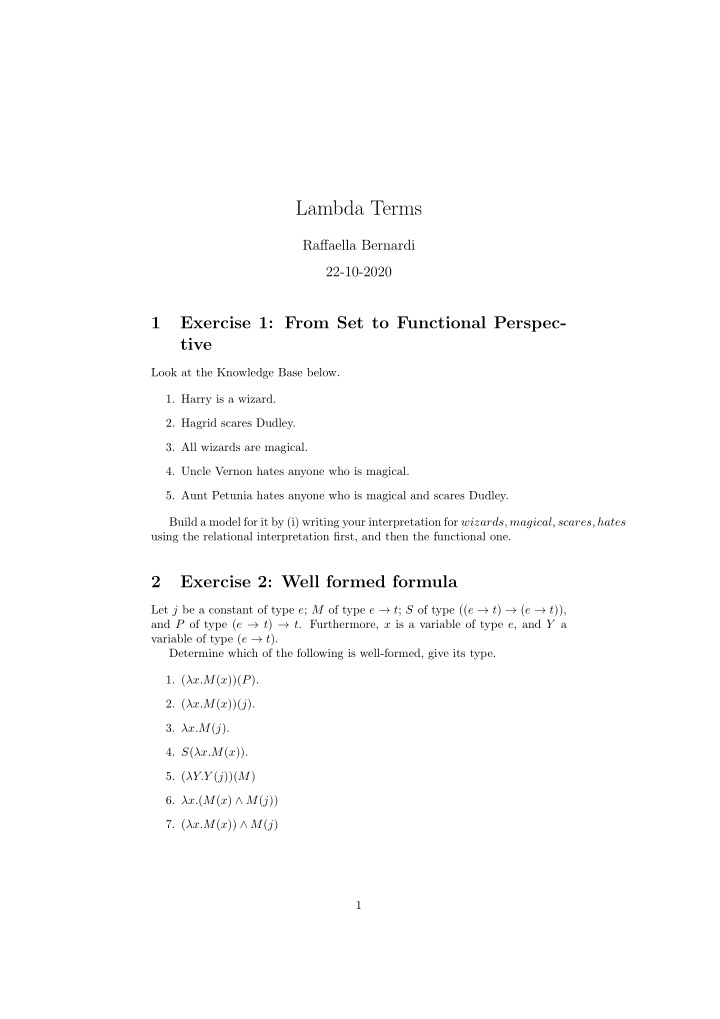



Lambda Terms Raffaella Bernardi 22-10-2020 1 Exercise 1: From Set to Functional Perspec- tive Look at the Knowledge Base below. 1. Harry is a wizard. 2. Hagrid scares Dudley. 3. All wizards are magical. 4. Uncle Vernon hates anyone who is magical. 5. Aunt Petunia hates anyone who is magical and scares Dudley. Build a model for it by (i) writing your interpretation for wizards, magical, scares, hates using the relational interpretation first, and then the functional one. 2 Exercise 2: Well formed formula Let j be a constant of type e ; M of type e → t ; S of type (( e → t ) → ( e → t )), and P of type ( e → t ) → t . Furthermore, x is a variable of type e , and Y a variable of type ( e → t ). Determine which of the following is well-formed, give its type. 1. ( λx.M ( x ))( P ). 2. ( λx.M ( x ))( j ). 3. λx.M ( j ). 4. S ( λx.M ( x )). 5. ( λY.Y ( j ))( M ) 6. λx. ( M ( x ) ∧ M ( j )) 7. ( λx.M ( x )) ∧ M ( j ) 1
3 Exercise 3: β -conversion Let j be a constant of type e ; M of type ( e → t ), and A of type e → ( e → t ). Furthermore, x and y are variables of type e , and Y is a variable of type e → t . Reduce the following expression as much as possible by means of β -conversion. 1. λx ( M ( x ))( j ) 2. λY ( Y ( j ))( M ) 3. λxλY ( Y ( x ))( j )( M ) 4. λx ∀ y ( A ( x )( y ))( j ) 5. λx ∀ y ( A ( x )( y ))( y ) 6. λY ( Y ( j )) λx ( M ( x )) 7. λY ∀ x ( Y ( x )) λy ( A ( x )( y )) 2
4 Solutions 4.1 Exercise 1 [ [ wizard ] ] = { harry } { x | wizard ( x ) = 1 } [ [ magical ] ] = { harry } { x | magical ( x ) = 1 } [ [ scares ] ] = { ( hagrid, dudley ) } { ( x, y ) | ( scares ( y )) ( x ) } [ [ hates ] ] = { ( vernon, harry ) } { ( x, y ) | ( hates ( y )) ( x ) } 4.2 Exercise 2 1. ( λx.M ( x ))( P ). [NWF] 2. ( λx.M ( x ))( j ). [WF] 3. λx.M ( j ). [NWF: vacus abstraction] 4. S ( λx.M ( x )). [WF] 5. ( λY.Y ( j ))( M ) [WF] 6. λx. ( M ( x ) ∧ M ( j )) [WF] 7. ( λx.M ( x )) ∧ M ( j )) [NWF: λx.M ( x ) and M ( j ) are of types e → t and t , resp. ∧ coordinates terms of types t ] 4.3 Exercise 3 1. λx ( M ( x ))( j ) [ M ( j )] 2. λY ( Y ( j ))( M ) [ M ( j )] 3. λxλY ( Y ( x ))( j )( M ) [ M ( j )] 4. λx ∀ y ( A ( x )( y ))( j ) [ ∀ y.A ( j )( y )] 5. λx ∀ y ( A ( x )( y ))( y ) [ ∀ y.A ( z )( y )] 6. λY ( Y ( j )) λx ( M ( x )) [ M ( j )] 7. λY ∀ x ( Y ( x )) λy ( A ( x )( y )) [ ∀ z.A ( x )( z )] 3
Recommend
More recommend